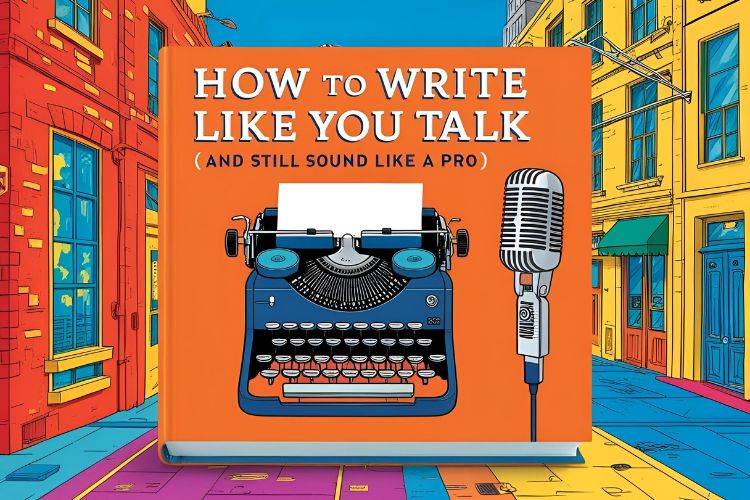Currently Empty: ₹0.00
Learning
How to Write Like You Talk (And Still Sound Like a Pro)

You’re not a giant corporation with a legal team approving every word.
So why does your content read like a user manual?
Many small business owners fall into the trap of over-editing, overthinking, and trying to “sound professional” — only to end up sounding stiff, robotic, or worse… forgettable.
If your content doesn’t sound like you, it won’t connect with them.
The good news? You can be natural and conversational without sacrificing credibility.
In fact, that’s exactly what builds trust.
This post will show you how to:
- Write like you talk — but better
- Keep it human, clear, and still polished
- Avoid the biggest tone mistakes that cost you connection and conversion
Let’s find your voice — and use it like a pro.
Why “Conversational” Doesn’t Mean “Unprofessional”
Let’s clear this up: Writing in a conversational tone doesn’t make you less credible. It makes you more relatable — and more likely to be remembered.
Too many small business owners think they have to sound formal to be taken seriously.
So they default to stiff intros, passive voice, and industry jargon that no one actually talks like.
Here’s the truth
- People don’t connect with brands — they connect with people.
- Conversational doesn’t mean sloppy — it means clear, direct, and real.
- The goal isn’t to “dumb down” your message — it’s to remove the friction.
Consider this:
Formal: “Our team is committed to providing unparalleled solutions tailored to meet your evolving business needs.”
Conversational: “We help you solve real business problems — without the fluff.”
Same intention. Different impact.
Which one would you rather read?
The 3 C’s of Writing Like You Talk
You don’t need to be a “great writer” to write like yourself.
You just need to follow three simple rules — the 3 C’s:
- Clarity
Say exactly what you mean — no fancy words or filler fluff.
Example:
Don’t say: “We endeavor to empower entrepreneurs to actualize their business potential.”
Say: “We help small business owners grow with practical tools.”
Tip: If your sentence sounds like it belongs in a brochure, rewrite it.
- Confidence
Write like you believe in what you’re saying.
No “maybe,” “just,” “I think,” or “sorry to bother you.”
Swap this:
“Just wanted to quickly share a few tips…”
For this:
“Here are 3 tips that can actually move the needle.”
Own your expertise. It shows up in your tone, even if you’re not aware of it.
- Casual Polish
Write how you speak — but cleaner.
Think “smart text to a client,” not “raw voice note to your best friend.”
Keep: contractions, friendly tone, simple words
Clean up: run-on thoughts, sloppy punctuation, unnecessary tangents
Together, these three give you writing that feels human, sounds smart, and builds trust.
Ready to make it even easier?
Quick Tricks to Sound More Human (Without Sounding Sloppy)
You don’t need a writing degree to sound natural.
These small tweaks can instantly make your content feel more “you” — and more engaging:
- Read It Out Loud
If it sounds weird when you say it, it’ll feel weird when someone reads it.
Reading aloud helps catch stiffness, awkward phrasing, or over-complication.
- Use Contractions
“You are going to love this” → “You’re going to love this”
It’s a small change, but it instantly makes your writing feel more like a conversation.
- Cut the Jargon and Fillers
Drop overused phrases like “leveraging synergies” or “revolutionizing the landscape.”
Also ditch the “just,” “a little,” and “kind of” — unless you really mean them.
- Start With “You,” Not “We”
Talk to your reader — not about yourself.
“You’ll get clarity in 30 minutes” hits harder than “We provide clarity in 30-minute sessions.”
- Keep Sentences Short and Punchy
Long sentences dilute impact.
Short ones drive it home.
Try applying just two of these to your next post or email — you’ll notice the shift immediately.
Tools and Prompts to Find Your Voice
Writing like yourself isn’t about copying someone else’s style — it’s about uncovering your own.
These tools and prompts make that easier:
- Use Voice Notes
Talk first, write later. Record yourself explaining an idea as if you’re chatting with a friend — then transcribe it. You’ll be surprised how clear and natural your spoken tone already is.
- Try the “DM Trick”
Write your post or caption as if you’re sending it to one person you actually know — not the internet. This instantly strips away formality and makes your message more personal and direct.
- Use the Hemingway App
Paste your text into Hemingway to highlight overly complex sentences. It helps you simplify without dumbing down.
- Use ChatGPT
Need to rewrite a stiff paragraph into a friendlier tone? Paste it and ask for a “conversational rewrite.” You’ll get a smoother, clearer version in seconds.
- Practice This Prompt Weekly
“If I had to explain [topic] to my favorite client in a voice note, how would I say it?”
Use that as your starting point — then polish.
Your real voice is already powerful. These tools just help you hear it clearly.
Final Thoughts: Your Voice Is Your Brand
You don’t need a perfect writing style.
You need a real one — one that sounds like you and builds trust with them.
Your voice isn’t just how you write.
It’s how your audience feels when they read, listen, or scroll through your content.
If you sound like a real person, people are more likely to trust you.
And if they trust you, they’re more likely to buy from you.
So ditch the corporate tone.
Talk like you care. Write like you mean it.
Because that’s what turns content into connection — and trust into action.